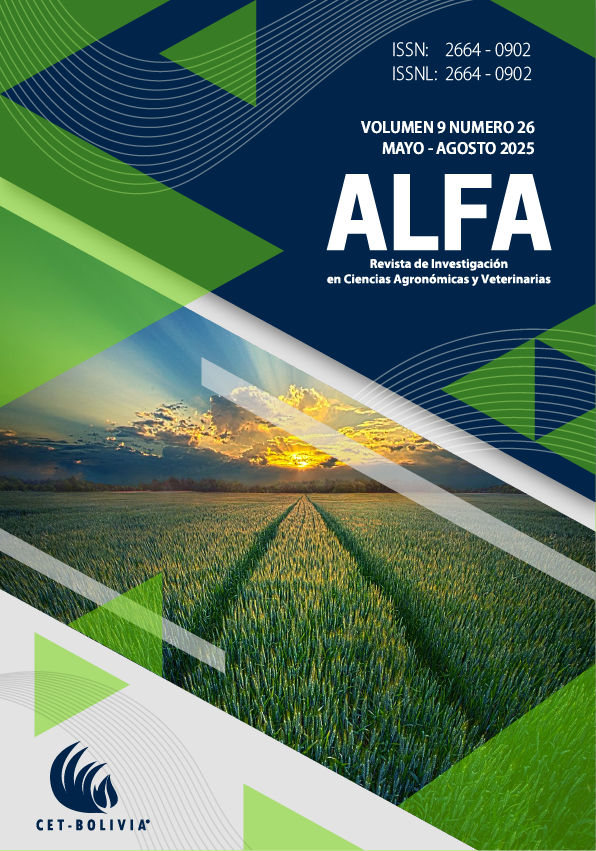Evaluación del enriquecimiento ambiental en tortugas: Impacto en su comportamiento y bienestar
Evaluation of environmental enrichment in turtles: Impact on their behavior and welfareContenido principal del artículo
El impacto del enriquecimiento ambiental en el comportamiento y bienestar de tortugas en cautiverio en el Centro de Paso de Fauna Silvestre de la Universidad Agraria del Ecuador. El objetivo fue analizar las diferentes estrategias de enriquecimiento físico y alimenticio influyen en la conducta y adaptación de diversas especies de tortugas. La metodología consistió en un diseño experimental longitudinal, observando a 27 tortugas durante tres fases: antes, durante y después de la aplicación de enriquecimientos, registrando variables como alerta, exploración, alimentación, descanso e interacciones sociales mediante etogramas. Los resultados mostraron un aumento significativo en el comportamiento exploratorio durante la fase de enriquecimiento, especialmente en Trachemys scripta (34%) y Chelonoidis carbonaria (41%). Además, especies como Kinosternon leucostonum y Trachemys scripta prefirieron camarones congelados (81%). Tras retirar los enriquecimientos, la exploración se mantuvo elevada en algunas especies. Se concluye que el enriquecimiento ambiental mejora la adaptabilidad y reduce el estrés, recomendándose su implementación continua en centros de rescate y rehabilitación.
The impact of environmental enrichment on the behavior and well-being of captive turtles at the Wildlife Transit Center of the Agrarian University of Ecuador. The objective was to analyze how different physical and nutritional enrichment strategies influence the behavior and adaptation of various turtle species. The methodology consisted of a longitudinal experimental design, observing 27 turtles during three phases: before, during, and after the application of enrichments, recording variables such as alertness, exploration, feeding, resting, and social interactions using ethograms. The results showed a significant increase in exploratory behavior during the enrichment phase, especially in Trachemys scripta (34%) and Chelonoidis carbonaria (41%). Furthermore, species such as Kinosternon leucostonum and Trachemys scripta preferred frozen shrimp (81%). After the enrichments were removed, exploration remained high in some species. It is concluded that environmental enrichment improves adaptability and reduces stress, and its continued implementation in rescue and rehabilitation centers is recommended.
Descargas
Detalles del artículo
Broom D, Molento C. Bem-estar animal: conceito e questões relacionadas – revisão. Arch Vet Sci. 2004;9(2):1-11. https://n9.cl/rdx2x3
Mellor D. Operational Details of the Five Domains Model and Its Key Applications to the Assessment and Management of Animal Welfare. Animals (Basel). 2017;7(8):60. https://doi.org/10.3390/ani7080060
Burghardt G. Environmental enrichment and cognitive complexity in reptiles and amphibians: Concepts, review and implications for captive populations. Appl Anim Behav Sci. 2013;147(3-4):286-298. https://doi.org/10.1016/j.applanim.2013.04.012
Newberry R. Environmental enrichment: Increasing the biological relevance of captive environments. Appl Anim Behav Sci. 1995; 44:229-243. https://n9.cl/i9tsr
Pincay C. Implementación de un programa de enriquecimiento ambiental en piscinas para tortugas marinas del centro de rehabilitación de fauna marina Manabí-Puerto López. Guayaquil: Universidad Agraria del Ecuador; 2021. https://n9.cl/44wqu
Baines F. Health and Welfare of Captive Reptiles, Second Edition - Edited by C Warwick, PC Arena and GM Burghart. Cham: Springer; 2023. https://goo.su/qI49Pi
Rose P. Ensuring a good quality of life in the zoo: Underpinning welfare-positive animal management with ecological evidence. 2018. https://goo.su/hSNU50
Ministerio del Ambiente, Agua y Transición Ecológica del Ecuador. Resolución Nro. 001: Plan de Acción para la Conservación de las Tortugas Marinas en Ecuador. Quito: Ministerio del Ambiente; 2021. https://n9.cl/plantortugas
Estrada G, Parra J. Enriquecimiento ambiental de fauna silvestre sometida a cautiverio en el hogar de paso Uniamazonia - Corpoamazonia. Rev CES Med Vet Zootec. 2007;2(2):8-13. https://n9.cl/eexlvh
Howard D, Freeman M. Overlooked and under-studied: a review of evidence-based enrichment in Varanidae. J Zool Bot Gardens. 2022;3(1):32-43. https://doi.org/10.3390/jzbg3010003
Diggins R, Burrie R, Ariel E, Ridley J, Olsen J, Schultz S, et al. A review of welfare indicators for sea turtles undergoing rehabilitation, with emphasis on environmental enrichment. Anim Welf. 2022;31(2):219-230. https://doi.org/10.7120/09627286.31.2.006
Kanghae H, Thongprajukaew K, Inphrom S, Malawa S, Sandos P, Sotong P, et al. Enrichment devices for green turtles (Chelonia mydas) reared in captivity programs. Zoo Biol. 2021;40(5):407-416. https://doi.org/10.1002/zoo.21613
Learmonth M, Sherwen S, Hemsworth P. Assessing preferences of two zoo?housed Aldabran giant tortoises (Aldabrachelys gigantea) for three stimuli using a novel preference test. Zoo Biol. 2021;40(2):98-106. https://doi.org/10.1002/zoo.21585
Escobedo-Bonilla C, Quiros-Rojas N, Rudín-Salazar E. Rehabilitation of marine turtles and welfare improvement by application of environmental enrichment strategies. Animals (Basel). 2022;12(3):282. https://doi.org/10.3390/ani12030282
Andrade C, de Oliveira H, de Lima A, da Mota J, da Silva Azevedo S, de Oliveira A, et al. Community-based conservation and management of chelonians in the amazon. Front Ecol Evol. 2022; 10:769328. https://doi.org/10.3389/fevo.2022.769328
Fernandez E, Martin A. Animal training, environmental enrichment, and animal welfare: A history of behavior analysis in zoos. J Zool Bot Gardens. 2021;2(4):531-543. https://doi.org/10.3390/jzbg2040038
Zhang Z, Gao L, Zhang X. Environmental enrichment increases aquatic animal welfare: A systematic review and meta?analysis. Rev Aquac. 2022;14(3):1120-1135. https://doi.org/10.1111/raq.12641

